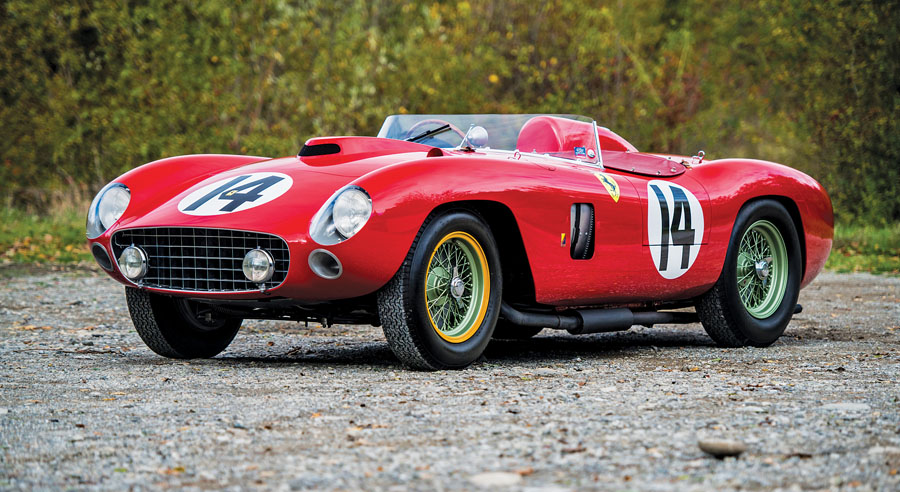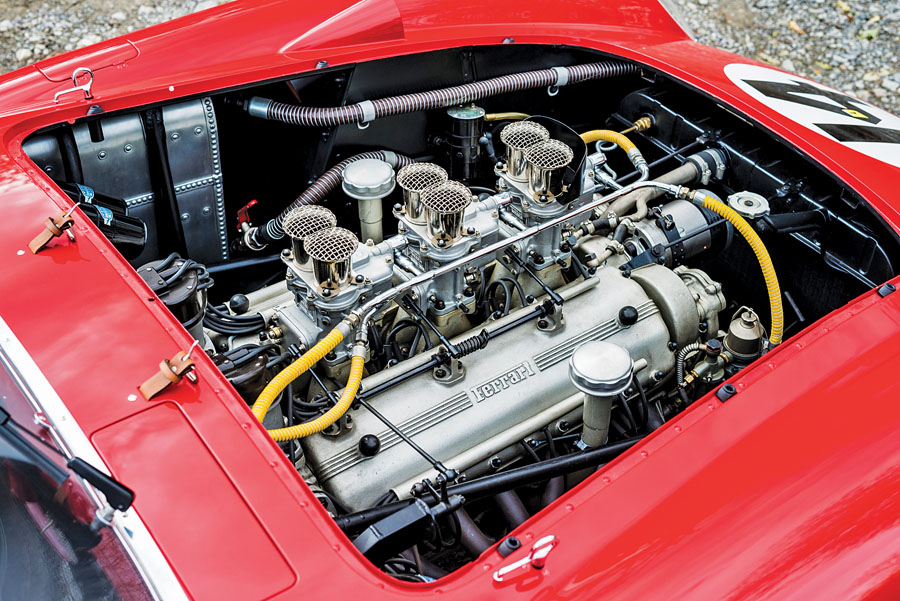SCM Analysis
Detailing
| Vehicle: | 1956 Ferrari 290 MM by Scaglietti |
This car, Lot 241, sold for $22,005,000, including buyer’s premium, at RM Sotheby’s Petersen Automotive Museum sale on December 8, 2018, in Los Angeles, CA.
Let’s start by stating the basic conundrum: Yeah, $22 million is one heck of a lot of money, but it is not even close to what a mediocre 250 Testa Rossa would be expected to bring, and the Ferrari 290 MM is far rarer, more exotic and has better racing history than all but the best of the TRs.
What is going on here?
Is this 290 MM really worth less than the newer, simpler cars, or is something else going on? Is the market for “crown jewels” starting to soften — or are we looking at the wrong things?
I think that there are reasonable answers to these questions, but making sense is going to involve getting familiar with the various evolutionary paths that sports racing Ferraris followed through the 1950s.
It all starts with the engines
As a point of beginning, it is useful to understand Ferrari’s engines in this period. Although the variations seem almost infinite, there were four basic ones: a small and a large V12 and the same for inline 4s.
The small V12 is generally referred to as the Colombo 250 engine after the designer and its displacement per cylinder, and it is limited by its design to 3 liters.
The large V12 is referred to as the Lampredi V12, and it is a very different engine. It is a monobloc design (cylinders and heads in a single casting) instead of the conventional block with removable heads of the Colombo. This engine was built anywhere from 3 to well over 4 liters. These shared a chain-driven SOHC valve-train approach, which made them suitable for road or competition use, although some of the last Lampredi racing engines were 4-cams.
The 4-cylinder engines were Lampredi designs, also small and large, with the small either 2 or 2.5 liter (500 and 625) and the large being mostly 3 liter (750) with a few 3.4 liter (860). They shared a twin-cam architecture and used a gear-tower cam drive, which made them unsuitable for road use.
They were light, high torque, and relatively powerful units that anchored much of Ferrari’s Formula car and sports racing efforts into 1956. Ferrari attempted a 6-cylinder version of the big four in 1955, but it proved unreliable and was abandoned.
Three generations
The sports racing Ferraris of the 1950s can be thought of as three distinct generations.
The first generation was not fundamentally different than the road cars. They had ladder frames with live rear axles and essentially the same bodywork as the street versions. They were exclusively V12 powered.
Starting in 1954, the pure racers began to diverge from the street cars, with the racers getting more-sophisticated frame designs, transaxles, de Dion rear suspensions, ultra-lightweight bodies without provision for weather protection or normal road use, and primarily 4-cylinder engines.
This lasted until what I call the Italian horsepower wars got serious beginning in 1956.
Into 1957 both Ferrari and Maserati built bigger and more-powerful engines until Alfonso de Portago’s fateful accident at the 1957 Mille Miglia brought it all to a screeching halt. I refer to this group of cars as the second generation of Ferrari racers, and it is our primary focus today.
The Mille Miglia accident, which killed de Portago, his co-driver, and nine spectators, marked the end of an era as well as the Mille Miglia. Both the Italian government and the FIA outlawed racing engines over 3 liters starting in 1958, which marked the end of the second-generation Ferrari racers.
Forced to return to 3-liter horsepower, they chose to abandon the transaxle complexity of the Monza/Sport series and tried putting a 250 Colombo engine into one of the smaller, live axle, 2-liter 500 TRC chassis that were designed primarily for privateer use. Thus the 250 Testa Rossa was born, and with it the third generation of racing Ferraris.
The Horsepower Wars
To understand our subject 290 MM, we need to go back and spend more time with the Horsepower Wars. Ferrari entered the 1955 season committed to the 750 Monza as its mainstay, with the new 6-cylinder 121 LM for fast tracks such as Le Mans.
The 6-cylinder engine had lots of power, but it never really worked and was quickly abandoned, leaving Ferrari stuck for a big gun. They responded by developing the 3.4-liter 860 Monza late in the season, which was an excellent engine, but was as big as any 4-cylinder design could possibly get.
Mercedes-Benz withdrew from racing at the end of 1955. With Jaguar only interested in Le Mans, that left Ferrari and Maserati as the only serious contenders for the 1956 championship, and both companies took it very seriously.
Maserati had the excellent 300S and were known to be developing a 4.5-liter V8, so Ferrari had to rethink its approach to keep up with the horsepower race.
The 860 Monza had the horsepower for the time being, but it couldn’t get any bigger, so the new chief engineer Vittorio Jano revised the Lampredi V12 to twin ignition for greater efficiency and installed it into the 860 Monza chassis to create the 290 MM.
Aside from the engine (and some hood bumps), the cars were identical.
Our subject car — chassis 0628 — spent the 1956 season as an 860 Monza and did very well, taking 2nd to Castellotti’s 290 MM at the Mille Miglia, but the Horsepower Wars continued to rage.
Jano further revised the Lampredi V12 to twin cams and larger displacement to counter Maserati’s 450S with the 315 and 335 Sport, and chassis 0628 served as a test bed for the 315 engine before getting a 290 MM engine for the 1957 season.
Then it was all over, as de Portago’s crash of a 335 Sport was the end of the second-generation Ferraris.
Starting in 1958, the third-generation Testa Rossas (and GTOs) are what captured the world’s imagination, even though they are mechanically nowhere near as exotic — and few have the factory team histories of the earlier cars.
Markets are markets, though, and everybody wants a TR. I don’t think you could hope to find a 1958 TR for less than probably $35 million, and the 1959 and 1960 cars would be well above that if any could be bought.
Why are 290 MM cars cheaper than Testa Rossas?
All this makes $22 million for this 290 MM seem pretty cheap. Why?
I think that the basic deal is that the second-generation V12 cars are much more difficult to sell than Testa Rossas. There are only a few of each second-gen V12 car, so they are harder to understand (or explain to your buddies), and generally aren’t quite as pretty.
However, a sister 290 MM sold for $28 million in December 2015, and the wildly exotic 335 S variant sold for $35.9 million in February 2016, so something still seems to be amiss.
It is tempting to note that this car started out as an 860 Monza, which as a 4-cylinder car would be worth maybe half of the V12 car, but I doubt this is much of an issue. Our subject car had great history as an 860, and was converted to and raced by the factory as a 290 MM, so there are no provenance issues.
A long time on the market
I am sure that it didn’t help that this car had been more or less actively on the market for at least two years — with an asking price far higher than was realistic. This means that most any serious buyer for the car had already considered it and said no.
Putting a heavily exposed car into an auction generally signals that the seller has given up, which doesn’t bode well for high expectations at the sale. To complicate things, the asterisk in the catalog description saying that the consignor had been guaranteed a minimum price effectively meant that RM or a backer had already bought the car. The question was whether an outside buyer thought it was worth more than the guarantee when the bidding stopped.
In the end, the car sold for a relatively short — although probably reasonable — amount of money for a truly important and exciting car. I would suggest that this car is well bought, probably as a financial play rather than a long-term collector hold.
We’ll see if it shows up again in a few years. ♦
(Introductory description courtesy of RM Sotheby’s.)

